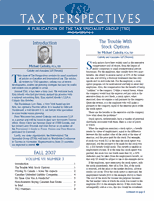
PDF Format
 Issue Contents Issue Contents
 All Issues All Issues
Fall 2007
Volume 7, Number 3
The information in Tax Perspectives is prepared for general interest only. Every effort has been made to ensure that the contents are accurate. However, professional advice should always be obtained before acting and TSG member firms cannot assume any liability for persons who act on the basis of information contained herein without professional advice.
In Brief
By Howard L. Wasserman, CA, CFP, TEP
Cadesky and Associates LLP (Toronto)
Canada - U.S Treaty
On September 21, 2007, the Fifth Protocol to the Canada-U.S. Income Tax Convention was signed by the Minister of Finance and the U.S. Secretary of the Treasury. The Fifth Protocol will enter into force on the later of the date it is ratified by both governments or on January 1, 2008. Key aspects of the treaty are as follows:
- It eliminates withholding tax on cross-border interest payments to both arm's length parties and non-arm's length parties. There will be a phase-in for non-arm's length interest, reducing the rate from 10% to nil over three years.
- Treaty benefits will be extended to limited liability companies ("LLCs"). This has been a significant issue for many years, since LLCs are so prevalent in the United States. If the shareholders of an LLC are U.S. residents, the treaty will apply to them.
- Taxpayers will now be able to settle certain issues, such as transfer pricing disputes, through binding arbitration.
- New rules attempt to avoid double taxation when a taxpayer moves from one country to the other.
- The taxation of stock options between the two countries is clarified, in an attempt to avoid double taxation of the benefits.
Foreign Investment Entities ("FIE")
The Bill that incorporated the changes to the FIE draft legislation received first reading in the Senate on June 18, 2007.
The FIE legislation is supposed to be effective from January 1, 2007. However, the Parliamentary session ended without the Bill becoming law, so the Bill dealing with FIEs (and non-resident trusts) will have to be re-introduced.
This delay could result in the legislation not being passed by the time the first FIE reports are due next April. We shall have to wait and see.
Pension Income Splitting
When filing their 2007 personal income tax returns, Canadian residents will be able to split pension income with their spouse. The pension income that can be split is defined as "eligible pension income", being:
- The taxable part of annuity payments from a superannuation or pension fund or plan; and
- Amounts received by a surviving spouse or a person 65 years or older from
- Annuity and RRIF payments
- RRSP annuity payments
In order to split the eligible pension income, Form T1032 must be completed by the recipient of the pension and their spouse. Tax withheld from eligible pension income will be allocated in the same proportion as the pension income.
This is a significant tax savings opportunity for those receiving eligible pension income.
SR&ED Discussion Process
The Canada Revenue Agency and the Department of Finance recently issued a Consultation Paper asking for input concerning ways to improve the SR&ED tax incentive program. The government is trying to identify "priority areas" where the program needs improvement. They request suggestions about how to streamline the program administration.
|